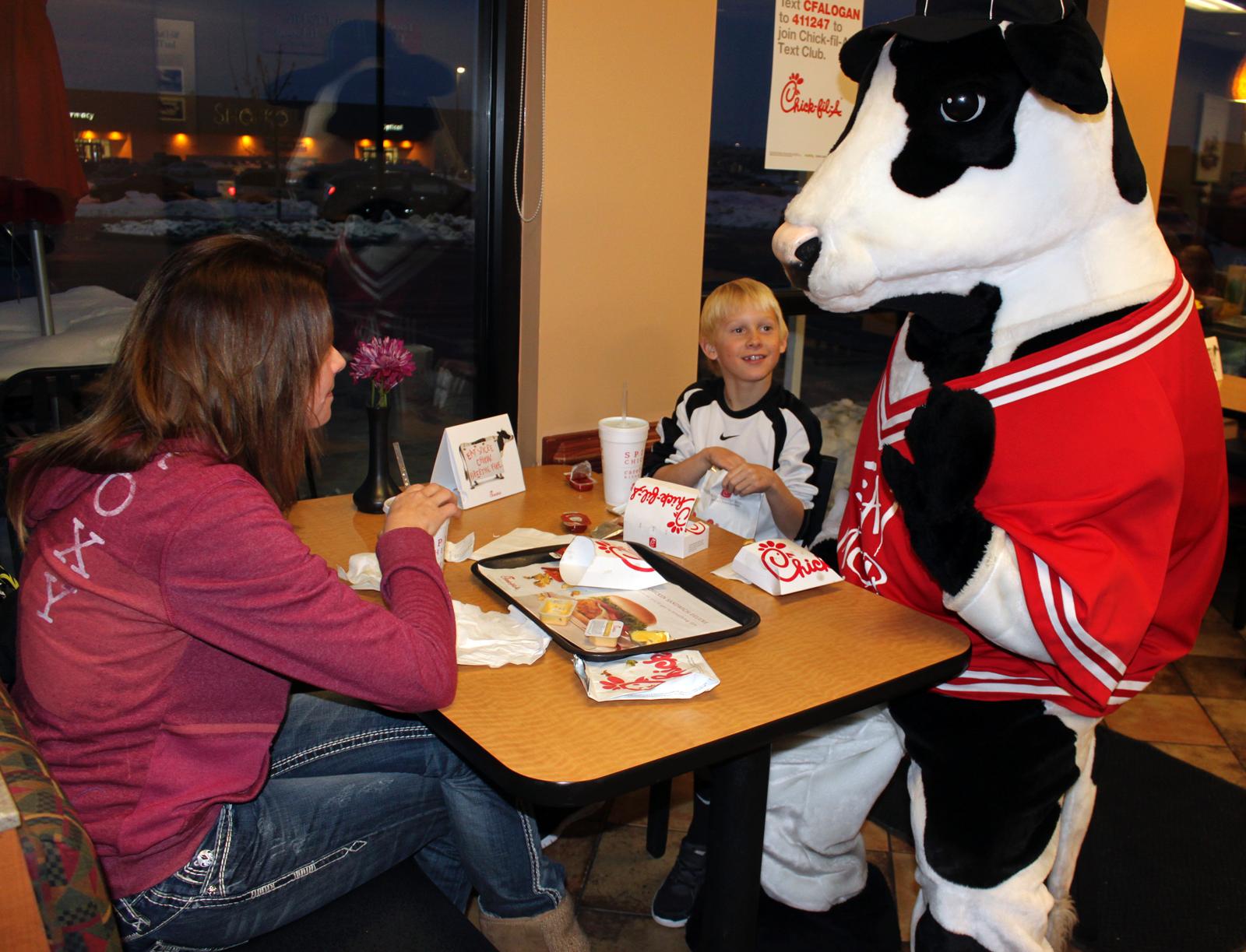Behind the cow costume
A small, blond boy high-fives a person in a black-and-white cow costume in the middle of a fast food restaurant. With a grin, he watches the cow shake a cowbell as it walks away to greet the other children. Scenes such as this are typical of an afternoon at Chick-fil-A.
The cow mascot serves not only as a promoter for the slogan, “Eat Mor Chikin,” he also provides entertainment for customers, including children.
“It’s nice to see people’s reactions and all the little kids wave and give you hugs,” said Dustin Hicken, a freshman majoring in computer science.
Hicken has worked at Chick-fil-A for two months and has already had the opportunity to play the cow. Two cow costumes are always on hand to accommodate large events, such as National Cow Day.
Every June, Chick-fil-A fans across the nation are given the chance to dress up in their own cow attire and are rewarded with a free meal. On such days, both cows are on site and employees who fit the height criteria – between 5 feet 9 inches and 6 feet or between 5 feet 2 inches and 5 feet 7 inches – are able to play the roles. However, before anyone is assigned to play the part of the cow, they have to watch tutorials, said Sarah Spencer, a freshman majoring in psychology and Chick-fil-A employee.
“You go through cow training,” Spencer said.
There are rules that must be learned before an employee dresses in the spots.
“The number one rule is you never talk,” Spencer said. “Once you’re in the seat you can talk in the back when they’re getting you dressed. You have a helper called the cow handler. They help you get dressed and then undressed. And once you walk out the door, nothing. No words.”
However, the cow is still expected to interact with customers without speaking.
“Little kids will talk to you and you have to like, act out with your hands and no one knows what you’re talking about. You have to make big, bold movements,” Spencer said.
Special conferences are held around the country where all Chick-fil-A employees are trained to be successful cows. Spencer said she attended one in Utah where the top three cows demonstrated how to be good mascots through cartwheels. Energy and excitement cannot be stressed enough, she said. However, there are specific rules the cow must follow to protect not only herself, but also the name of Chick-fil-A.
“You’re not allowed to touch anyone’s face. You can, like, pat their head. And they have to see both hands at all times in pictures,” Spencer said.
While playing the part of the cow, the easiest way to ensure hand visibility is by putting one hand on a child’s shoulder and the other on your hip or in the air, he said.
However, a lot of the cow’s time is spent on the street. Regardless of the weather, he is required to dance and actively draw people’s attention while they drive by.
“You get so warm in the cow suit,” said Chloe Jensen, a senior at Logan High School. “It’s terrible in the summer.”
Many Chick-fil-A employees agree that summer is the worst time to play the cow.
“It was awful,” Spencer said about one of her past experiences. “You just walk into the store with just sport shorts on and just like, the thinnest T-shirt you have, you have your hair in a messy bun and sweatband because you get in it and it’s just so hot.”
Spencer said that one of her co-workers had been dressed up as the cow all day during a Pioneer Day Parade and passed out from a heat stroke after his shift.
“It’s hard, it’s very hard,” Spencer said. “So if I was gonna recommend it to someone, it would be someone that could handle it, and who could know how to have fun. If you like having fun and you’re not embarrassed to be a mascot, then yeah, totally. I’d totally recommend it.”
Spencer said Chick-fil-A employers are sympathetic toward employees because they understand the stressful and rigorous work that accompanies playing the part of the cow. The cow is offered more frequent breaks than a shift normally allows, and is encouraged to go home if he or she feels sick.
“They work with you really well,” Spencer said.
Not only is the cow costume difficult to wear in extreme weather, it also limits the wearer’s vision.
“When you’re in the cow outfit you have, like, tunnel vision,” Jensen admits.
Black mesh near the neck of the cow is the only way employees can see, making it difficult to watch their step. Hicken, Spencer, and Jensen all have stories of running into people and kicking objects on the floor, such as baby carriers.
“Always pay attention to where you’re walking,” Jensen said.
Spencer said that the cow is still an exciting role to play.
“I would recommend it to someone who was really outgoing and had the high energy to be able to do it,” he said. “I mean, it’s a hard job. It’s harder than you think. I wouldn’t choose to be the cow every day, but it’s fun. You’re getting paid to just be yourself and just be crazy and fun and hang out with little kids and hand out stickers.”
– kellice.b@aggiemail.usu.edu

